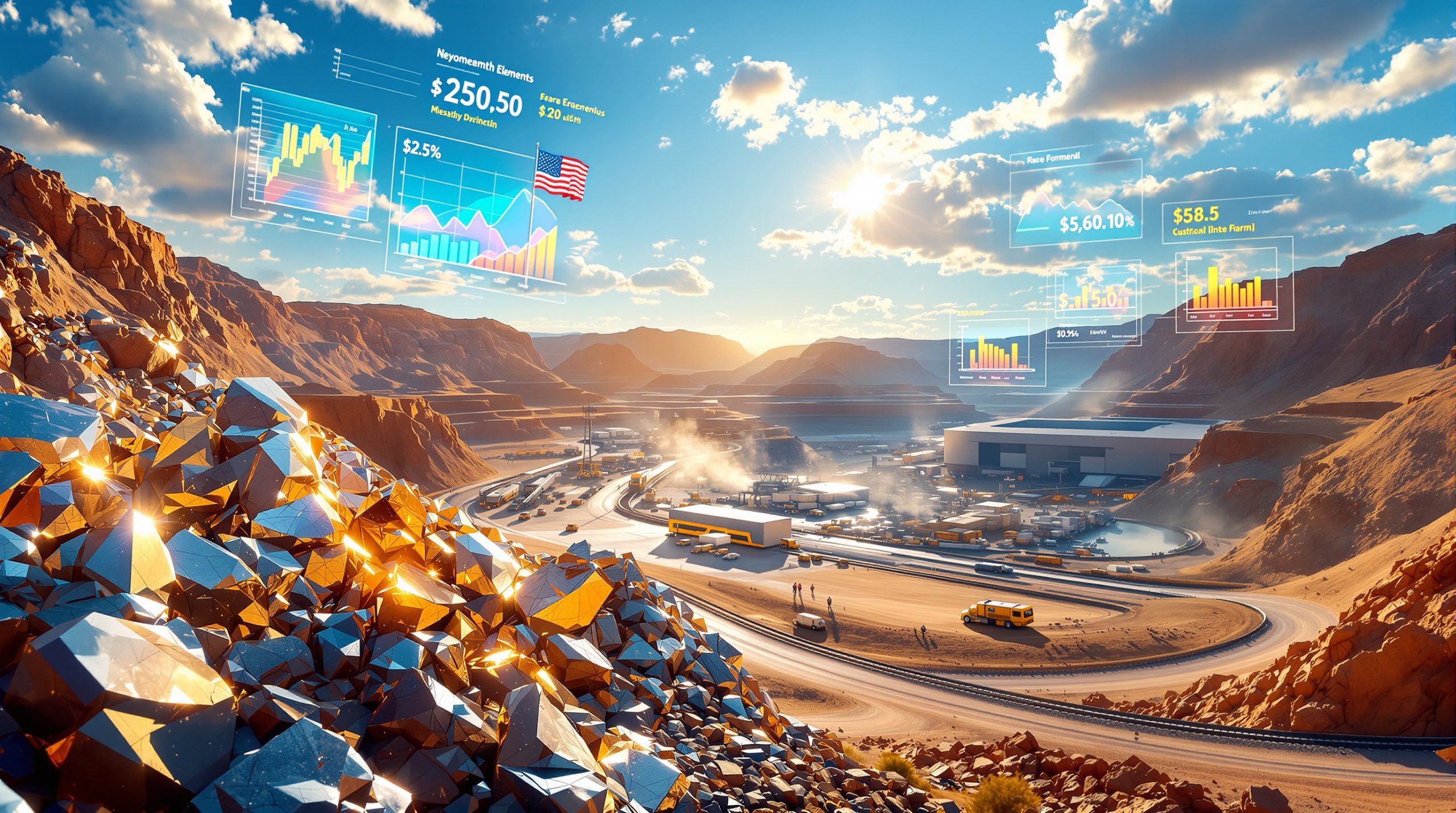Why Is Silver Reaching New Highs in 2024?
The Current Silver Rally in Context
Silver has reached a remarkable 14.5-year high, trading at levels not seen since September 2011. With prices climbing to approximately $37.70 per ounce, the precious metal market is experiencing its strongest momentum in over a decade. This impressive performance follows a distinctive pattern of sharp upward moves followed by sideways consolidation periods, establishing a stair-step pattern that technical analysts view as sustainable.
The current rally represents a significant breakthrough after years of underperformance compared to other assets. What makes this surge particularly noteworthy is its persistence despite broader market volatility, suggesting strong fundamental support rather than speculative excess. Understanding silver market squeeze insights can help investors navigate this dynamic environment.
Key Drivers Behind Silver's Price Surge
Several powerful factors are converging to drive silver's meteoric rise:
-
Historical undervaluation: The gold-silver ratio analysis exceeded 100:1 before the recent rally, a level that historically signals extreme undervaluation. As Florian Grooms, founder of Midas Touch Consultant, notes: "Silver was very undervalued with the gold-silver ratio above 100… [and] fundamentals look very good."
-
Industrial demand explosion: According to the World Silver Survey 2024, the global silver deficit reached 140.3 million ounces in 2023, with industrial applications consuming over 50% of total demand. The solar industry alone used 120 million ounces in 2023, a 15% year-over-year increase.
-
Supply constraints: Mining output has struggled to keep pace with demand growth. Primary silver mines face declining ore grades, with production costs averaging $15-20 per ounce according to S&P Global data.
-
Market mechanics: A significant factor in silver's explosive moves involves market positioning. Large short positions in the futures market are struggling to exit their positions, creating a potential short squeeze scenario that accelerates price increases.
-
Monetary catch-up: Silver is finally showing delayed follow-through from gold's earlier price increases, a pattern that typically occurs in precious metals bull markets.
"Supply struggles to match accelerating technological demand," explains Grooms, highlighting the fundamental imbalance driving prices higher.
What Are Experts Predicting for Silver Prices?
Short to Medium-Term Price Targets
Market analysts are watching key price levels as silver continues its upward trajectory:
-
The $40 per ounce level represents the next significant psychological barrier, with many experts expecting a test of this level in the near term.
-
$50 per ounce is projected as achievable within months, according to several industry forecasts. This would represent a return to the 2011 peak levels.
-
Price acceleration is widely expected once silver breaks through the $40 level, potentially creating a parabolic move similar to previous silver bull markets.
-
The current rally shows different momentum characteristics than anticipated, with stronger underlying support and less volatility on pullbacks.
"Silver will likely reach $50 in the short to midterm," predicts Grooms, suggesting this move could occur within a matter of months rather than years.
Long-Term Silver Price Outlook
Looking beyond immediate price targets, the long-term outlook for silver appears exceptionally bullish:
-
Triple-digit projections: Multiple analysts, including Grooms, project that silver could eventually reach $100+ per ounce. "Silver will see triple-digit numbers at some point," he states confidently.
-
Supply deficits: The structural imbalance between production and consumption is expected to persist. According to Metals Focus, 2024 could see a 200+ million ounce deficit.
-
Industrial demand trajectory: CRU Group's "Silver in Tech" 2023 report projects that AI infrastructure alone could add 500 million ounces of annual demand by 2030.
-
Historical context: During the 2010-2011 rally, silver rose approximately 400% from its base, according to Bloomberg data. A similar percentage move from recent lows would take prices well beyond $100.
For context, silver's all-time inflation-adjusted high from 1980 would equate to approximately $140 in today's dollars, suggesting significant upside potential remains despite the recent rally. Current silver squeeze market trends indicate continued momentum in this direction.
How Does Industrial Demand Impact Silver's Future?
Technology and Digital Infrastructure Requirements
Silver's unique properties make it irreplaceable in many high-tech applications:
-
Data center expansion: With AI development accelerating, data centers require extensive silver components. Each server contains approximately 0.5-1.0g of silver according to Intel's sustainability report 2023.
-
Electrical conductivity advantage: Silver's exceptional conductivity (63MS/m versus copper's 40MS/m) makes it crucial for microelectronics, as documented in the Journal of Materials Science 2022.
-
Digital transformation: As industries digitize operations, baseline demand for silver in circuit boards, switches, and connectors continues to grow exponentially.
-
Technical bottleneck: The supply chain cannot easily substitute other materials, as silver's thermal and electrical properties remain unmatched at scale.
"Nearly everything in the digital age requires silver," Grooms explains, highlighting the metal's critical role in modern technology infrastructure.
Green Energy Applications
The renewable energy revolution has created another massive demand channel for silver:
-
Solar panel intensity: Standard PERC solar cells require approximately 100mg of silver per watt of capacity, according to National Renewable Energy Laboratory (NREL) 2023 studies.
-
Policy accelerants: The U.S. Inflation Reduction Act alone is expected to add 25GW of solar capacity annually, requiring over 90 million ounces of silver according to Energy.gov projections.
-
Electric vehicle components: Tesla's 2023 Impact Report revealed a 20% increase in silver usage for EV components, representing an industry-wide trend.
-
Energy storage systems: Battery technologies increasingly incorporate silver for improved conductivity and performance.
Unlike gold, which is primarily held as an investment, approximately half of all silver is consumed industrially. More critically, the recycling rate for silver (15%) remains far below gold (75%) according to UNEP 2022 data, meaning much of this industrial silver is effectively removed from available supply. For investors looking to capitalize on these trends, an investing guide 2025 can provide valuable direction.
How Does Silver Compare to Other Precious Metals?
Gold vs. Silver Investment Strategy
The relationship between gold and silver offers important strategic insights for investors:
-
Price relationship: Gold currently trades around $2,300 per ounce, while silver sits at approximately $38, creating a gold-silver ratio of about 60:1 (down from over 100:1 in 2023).
-
Volatility profile: Silver historically exhibits greater volatility than gold, with a beta of 1.8x according to Bloomberg's 2024 analysis. This translates to potentially higher percentage returns during bull markets.
-
Current positioning: Many analysts, including Grooms, currently favor silver over gold at present price levels based on the ratio analysis.
-
Portfolio allocation: Experienced precious metals investors often maintain positions in both metals, with more conservative portfolios weighted toward gold and more aggressive strategies favoring silver.
The historical average gold-silver ratio of approximately 55:1 suggests silver remains slightly undervalued despite its recent outperformance.
Platinum's Investment Potential
Often overlooked in precious metals discussions, platinum offers a compelling alternative:
-
Historical premium: Platinum historically traded at a premium to gold, averaging 1.7x the gold price from 1971-2010 according to LBMA archives.
-
Current discount: At approximately $980 per ounce, platinum currently trades at an unusual 20% discount to gold.
-
Production economics: Platinum costs approximately $850 per ounce to produce (versus $450 for gold), according to S&P Global data, creating a tighter profit margin.
-
Supply constraints: The World Platinum Investment Council's Q2 report indicates a 280,000-ounce deficit for 2024.
"Platinum could trade again above gold," predicts Grooms, noting that in 1980, platinum peaked at $1,250 per ounce—2.5 times the gold price during the auto-catalyst boom.
For diversification purposes, some advisors recommend allocating a portion of precious metals holdings to platinum, particularly at current relative valuations. This approach aligns with broader commodities investment diversification strategies.
What Should New Investors Know About Physical Silver?
Smart Purchasing Strategies for Beginners
For those new to physical silver investing, these guidelines can help maximize value:
-
Start small: Begin with modest investments ($10-20 can purchase fractional silver) to learn the market dynamics before committing larger sums.
-
Focus on recognized products: Standard, widely recognized coins (American Eagles, Canadian Maple Leafs, Australian Kangaroos) offer better liquidity than exotic or numismatic pieces.
-
Calculate premiums: Determine the percentage over spot price using this formula: (Coin price ÷ spot price) − 1 = premium %. According to APMEX/Kitco data, premiums typically range from 8-30% depending on the product.
-
Comparison shopping: Check prices across multiple dealers before making purchases, as premiums can vary significantly.
"Avoid exotic numismatic coins… focus on liquidity," advises Grooms, emphasizing the importance of standardization for new investors.
Practical Considerations for Physical Holdings
Physical silver ownership requires thoughtful planning:
-
Denomination strategy: Choose smaller denominations (1oz coins, 5oz bars) for flexibility rather than large bars that cannot be partially liquidated.
-
Storage security: Non-bank vaults with LBMA/ISO 9001 certification (like SWP Cayman) offer professional security at approximately $8 monthly per $100,000 in value.
-
Banking considerations: Many experienced investors avoid storing precious metals with banking institutions due to potential accessibility concerns during financial stress periods.
-
Discretion practices: Maintain privacy regarding physical holdings to reduce security risks.
The physical premium over spot prices represents both a cost and a feature—while it increases the initial investment, it also reflects the real-world acquisition cost that supports price floors during market corrections. According to recent silver price forecasts, this premium may continue to be justified as market fundamentals strengthen.
What Broader Economic Concerns Impact Precious Metals Markets?
Financial System Instability Factors
Several macroeconomic trends support precious metals as portfolio insurance:
-
Global debt explosion: The Institute of International Finance's Global Debt Monitor reports total global debt has reached $315 trillion (Q1 2025), creating unprecedented systemic risk.
-
Bond market volatility: The MOVE Index (measuring Treasury volatility) remains elevated near 135, approaching 2020 crisis levels according to Federal Reserve data.
-
Interest burden: U.S. interest payments now consume approximately 17% of government revenue according to the Congressional Budget Office (July 2025), creating fiscal pressure.
-
Safe-haven dynamics: Precious metals have historically performed well during periods of financial instability, serving as portfolio insurance.
Silver's correlation to real yields (R² = 0.89 according to St. Louis Fed analysis) suggests continued strength as real rates remain challenged by inflation persistence. Recent analysis of silver market dynamics reinforces this perspective.
Digital Currency Developments and Implications
The evolving monetary landscape presents both risks and opportunities:
-
CBDC implementation: According to the Bank for International Settlements "Blueprint 2025" report, 98% of pilot Central Bank Digital Currency programs include programmable features that could restrict certain transactions.
-
Regulatory frameworks: Emerging policies could potentially limit precious metals transactions, as evidenced by India's 2024 gold import restrictions.
-
Financial freedom concerns: Centralized digital currency systems potentially create new forms of capital controls.
-
Education importance: Understanding evolving regulatory environments becomes crucial for precious metals investors.
"The risks of digital currencies potentially restricting metal conversion need serious consideration," suggests Grooms, highlighting the need for diversification beyond purely digital assets.
FAQs About Silver's Price Movement
Is silver's current price surge sustainable?
The fundamentals supporting silver's price increase appear exceptionally strong, with industrial demand growing while supply remains constrained. The pattern of sharp moves followed by consolidation suggests a sustainable upward trend rather than a speculative bubble. The global silver deficit of 140.3 million ounces in 2023 (World Silver Survey 2024) provides fundamental support for continued price strength.
What is the gold-silver ratio and why does it matter?
The gold-silver ratio measures how many ounces of silver it takes to purchase one ounce of gold. Historically, this ratio has averaged between 40:1 and 60:1. When the ratio exceeds 80:1, as it did recently (over 100:1), silver is considered undervalued relative to gold, suggesting potential for price appreciation. This ratio serves as a relative valuation tool for precious metals investors.
How might central bank policies affect silver prices?
Central bank monetary policies, particularly regarding interest rates and quantitative easing, significantly impact precious metals. Lower interest rates typically support higher precious metal prices by reducing the opportunity cost of holding non-yielding assets like silver. Additionally, expansionary monetary policies that increase money supply often correlate with higher precious metals prices as investors seek inflation hedges.
What is the best way to invest in silver?
Investment options include physical silver (coins/bars), silver ETFs, mining stocks, and futures contracts. Physical ownership offers security against financial system risks but requires secure storage. ETFs provide convenience but involve counterparty risk. Mining stocks offer leverage to metal prices but add company-specific risks. The optimal approach depends on individual investment goals, risk tolerance, and liquidity needs.
Disclaimer: This article contains market analysis and price projections that represent opinions rather than guaranteed outcomes. Precious metals investments involve risk, and past performance does not guarantee future results. Readers should conduct their own research and consult financial professionals before making investment decisions.
Ready to Profit from the Next Major Silver Price Move?
Discover how to capitalise on significant commodity price movements before the broader market with Discovery Alert's proprietary Discovery IQ model, which transforms complex market data into actionable investment insights. Visit the Discovery Alert discoveries page to understand how major mineral discoveries can lead to substantial returns for well-positioned investors.




